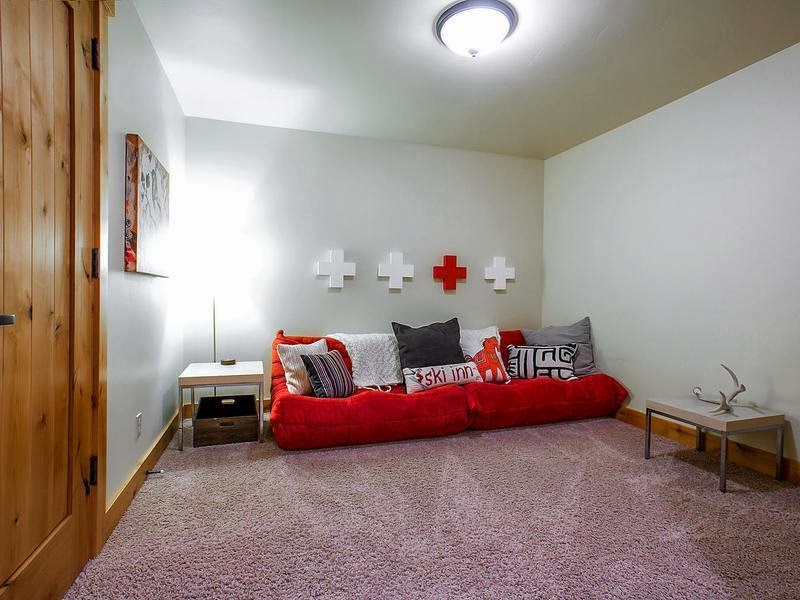With the Winter Olympics opening tomorrow in Russia, excitement, as well as
security concerns about Sochi, is mounting. While security and other issues surrounding the Games are obviously paramount, I felt compelled to see what I could learn about the ski houses in Sochi. With Russia's unique culture and extensive history, surely there would be some fascinating local snow-covered ski houses, right? I found that I had...and still have...a whole lot to learn before I can begin to understand anything about the ski houses there.
The first thing I learned is that Sochi is actually a seaside town, and more a summer resort than a winter one. But, beaches aside, the mountains are short distance (25 miles or so) away. There's a newly constructed train, and brand new roads to get from the sea to the mountains. This actually sounds like a fantastic location for a resort...beach and ski mountains in the same place - sweet! (Ooops, strike that...is it really true that part of the
beach has been paved over with concrete just before the Olympics?).
The next thing I learned is that Sochi and the areas around Rosa Khutor and Krasnaya Polyana, the Olympic ski venues, have a long, complicated, turbulent and even
"blood-soaked history".
Old mountain cottages of the past seem to have given way to the new construction blitz that has re-defined the mountain ski village as a sleek European style ski town, at least on its face. My own preference in a ski house, ski village (and mountain) is that they are true to their own identity and that of their local culture. According to
Russia Beyond the Headlines ("the Russian government's paper of record"), these "sleepy mountain roads are now filled with European-style ski chalets", viewed as surreal, "as if Russia had built a winter Disneyland in the mountains". But, I am unable to find details to learn more about these ski chalets (where are they? who designed them? who built them? are the for rent? for sale? who owns them?...), so my uncomfortable skepticism reminds me that Disneyland, after all, is the tangible version of a pretend world.
With initial news reports questioning the quality of some of the new, seemingly sleek accommodations, and the above reference to Russia's new Disneyland-like village, I can't help but wonder about the original local mountain cottages that may have literally given way for the sake of the Olympics and this copy-cat version of a European ski village.
Homes pushed aside for progress....a village redefined with a new identity? Maybe that's the ongoing echo of these mountains.
Whether or not this re-development will fuel the economy (or at least some narrow part of it) is yet to be seen, but it opens yet another chapter in the complex cultural evolution of these mountains.
Despite the overwhelming volume of new construction for the Olympics, there appears to be no houses lining the ski trails. However, the ski trails themselves...they do seem pretty impressive. Check out this bird's-eye
preview of Ted Ligety's giant slalom run on the Sochi slopes, the views from this lift ride up and
ski run down the slope, or this
pow ride. We're all cheering for the home team as they race the Sochi slopes!
In my research I'm accustomed to a multitude of details about ski houses in most resorts worldwide, but with this one, there seems to be a curious void of information. I can't be sure whether that is because there aren't really any houses that I'd call "ski houses" there, or whether there is simply a lack of published information about them. It's possible that because of the language barrier, I simply can't find an abundance of information. And it's also possible that as someone who understands the value of shared information, I am simply accustomed to information being readily available, and my expectations for details are too high. Whatever the reason, it seems to me that something is missing. As put by
National Geographic and a local businessman who had created an earlier version of this ski hill, "Things you build attract the attention of someone who can take them away." Maybe that sentiment hints at the void of ski houses, and/or information about them.
After searching, eventually (on
wikitravel) I found this photo of a ski house in Sochi's Olympic mountain venue area, Krasnaya Polyana ski area. It's title is the View at Aibga Ridge, from Polyana Grand, Krasnaya Polyana. To me it looks more North American than Russian, more Summer Olympics than Winter, but nonetheless the houses look welcoming, attractive and strong. I can't be certain, but perhaps this is the Disneyland-like mountain road filled with European ski chalets. Whatever it is, I like the sturdy logs, the familiar design, and the warmth of these all-wood ski houses. At least from the outside, these Russian ski houses look pleasantly inviting:
I hope that the warm strength of the logs in this ski house symbolizes the strength of the safety and security that will surround all the Olympians in Sochi.
In researching Sochi ski houses, my end result was more questions than answers. Maybe after the Olympics I'll be able to find some details about Sochi ski houses. (Anybody going? I'd love to hear a first-hand account of the ski houses!). I really hope that I can eventually find that elusive multitude of information, so I can continue to learn more about Sochi, its history, its Olympics, and its ski houses. There's so much to learn.
























